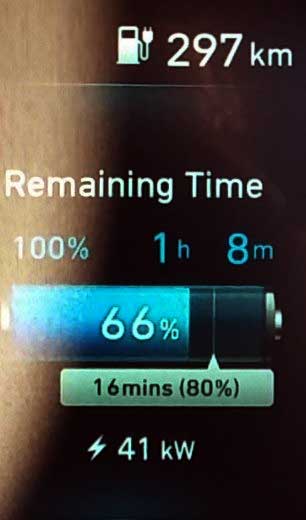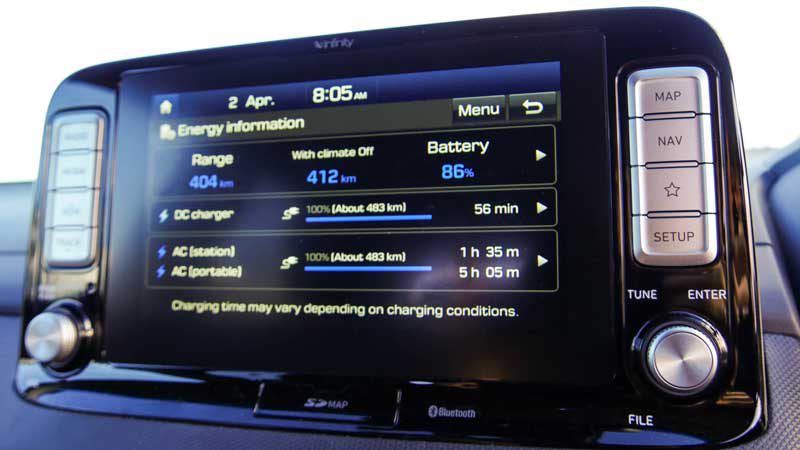We encourage questions from readers about electric vehicles, and charging, and whatever else you want to learn. Please send them through and we will get our experts to respond, and invite other people to contribute through the comments section.
Here’s the latest:
Hello Bryce
We drove to Torquay yesterday to try out the new ultra-fast charger at the RACV Club. I had the car DC charger set to 100% level. When we connected, it promised to be fully charged in 24 min. The remaining range before charging was 290 km.
After a coffee overlooking the golf course inside the Club we returned to find that it had charged to a level of 84% (or 420 km) in 32 minutes. (BTW: we paid $6.98 for 17.45 kWh at 40c per kWh).
The Ultra-fast charger worked well. I haven’t got to the bottom of the mismatch between charging level reported by the car and the range. Charging seems to slow down as the battery fills up above 80%.
What has been your experience with matching charging percentages and kilometres of range remaining? On another tangent we found that the google maps distance to Torquay was 123 km. The car reported 124 kms worth of range used for the trip. Much better than the Leaf’s guess-o-meter.
Arthur
Hi Arthur – yes, it’s fun to be driving a long-range EV, and thereby replace all one’s remaining fossil miles with electric ones. (And the discovery tour it sometimes takes us on as we learn about the subtle differences between driving an EV and a fossil-fuelled car!)
First-up: I think you might have miss-read the Kona ‘remaining time’ graphic. 24min to 80% would sound right, with 32min to 84% in that range. The confusion would have come from the Kona electric giving both 80% and 100% charge time estimates. (See figure 1).
 Fig. 1: Deconstructing the Kona electric Remaining Time graphic.
Fig. 1: Deconstructing the Kona electric Remaining Time graphic.
Current range: top (297 in this case)
Time to 100% charged: above battery image. (1h, 8 min)
Time to 80% charged: underneath battery image. (16 minutes)
Instantaneous charging rate: at bottom. (41kW)
Also – 40c/kWh seems a bit steep – but as EV drivers, we only use DC fast-charge occasionally (research show around 90% of EV charging is currently done at home or at work) so I suppose the initial installers of DC fast-charge equipment do deserve some return on investment, given the currently low adoption rate of EVs in Australia.
Longer term, the proliferation DC fast-chargers will keep them more honest. (I can also see a c/kWh price cycle developing for long weekends though 😉
The other thing you’ve noticed (and which I mention in my article here <The Great Australian Road Trip>) is the reason why manufacturers only quote 0 – 80% charging times. Whilst the 0 – 80% DC charging time for a Kona is 54 min, the 80 – 100% section takes just as long again! (Yes, the charge does taper off after 80% to look after the battery). This is the same for all EVs.
This is not a criticism of EVs though, just a difference. All it requires to get normal long distance travel times is a simple change in ‘refuelling’ habits. For EVs, the best approach for long-distance travel is to stop every 2hrs and only charge to 80% each time. (After leaving home with 100%). Makes for a 20 minute or so stop on each occasion.
For a Kona, you are only recharging from around 60% back up to 80% at the first stop, followed by 40% back to 80% each time after that. (Plus let it keep charging beyond 80% over your lunch or dinner).
Doing so also gives you plenty of rubber room to stretch to another charger along the way if for instance you want to visit a particular tourist site that has EV charging. For a Tesla – you can pretty much halve those times. The fact that EVs thereby encourage you to practice safe driving habits on long road trips is a bonus!
Re your comment re Leaf vs Kona range estimators (the early Leaf range estimator was christened by their owners as the ‘GOM’ or Guess-O-Meter, for its ever-reliable inability to make accurate predictions) – as a long-term driver of a 2011 Leaf and now a Kona owner – I am finding the Kona GOM extremely trustworthy, and yet another indicator of how much EVs have matured in their abilities since the first generation Leaf.
Many thanks for your questions Arthur – and for the opportunity to share them with the wider EV community. It is a good reminder that in some ways, the switch to EVs is a bit like the switch from horse and buggy to the ICE car.
By that I mean that some of the differences involve a subtle shift in mindset: like not having to feed the horses at night! Now it is that you no longer have to be a pump attendant to your fuel tank, instead you can have coffee or a snack while the charger does its work.

Bryce Gaton is an expert on electric vehicles and contributor for The Driven and Renew Economy. He has been working in the EV sector since 2008 and is currently working as EV electrical safety trainer/supervisor for the University of Melbourne. He also provides support for the EV Transition to business, government and the public through his EV Transition consultancy EVchoice.

